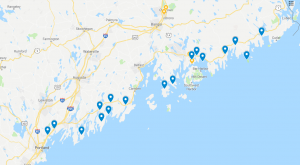Projects
In the last three years, the Maine Shellfish Restoration and Resilience Fund has supported 33 projects (14 in 2019, 15 in 2020, and 4 in 2021). These applied shellfish, conservation, and management projects focus on a diverse set of issues and strategies in Maine’s clam and mussel fisheries, including efforts to enhance clam populations through seeding and netting, diversify the fisheries and expand quahogs, cross-sector collaborations between wild fishermen and farmers, increasing access to shorelines, improving shellfishing survey techniques and sources of knowledge, find and fix pollution, innovate around water quality monitoring, and more. For select project profiles and more details about some of these efforts, visit The Mudflat website project profiles page here.
2021 Projects
- Beals, Studying adaptive strategies to understand and mitigate negative impacts of ocean acidification on shellfish recruitment and survival (Sara Randall)
- Bristol, Water testing to support reclassifying water quality status for Pemaquid River estuary and nearby John’s River Eastern Branch (Rachel Bizzaro)
- Downeast Rural Health Collaborative, Addressing Structural Barriers to Health among Shellfish Harvesters (Tora Johnson)
- Thomaston, Water quality outreach and tidal modeling in the St. George’s River watershed (David Taylor)
2020 Projects
- Bar Harbor, Clam population enhancement (Scott Swann)
- Bristol, Pemaquid River water quality efforts (Rachel Bizzarro)
- Brunswick, A collaborative approach between shellfish farmers and shellfishermen to bolster quahog populations in the intertidal shellfish growing areas (Dan Devereaux)
- Damariscotta, An assessment of shellfish resources for coastal resilience and management: Documenting historical and current trends in the Damariscotta River Estuary and Medomak River Estuary (Matt Lutkus and Heather Leslie)
- East Machias, Application to identify the source of contaminating coliforms on clam flats in East Machias Maine (Kevin Brodie)
- Freeport, Sustaining shoreline access for shellfish harvesting (Charles Tetreau)
- Freeport, Hands-on science education: Building a data set on clam recruitment and survival (Charles Tetreau)
- Frenchman Bay Regional Shellfish Committee, Investigation of Potential Shellfish Management Techniques to Increase Clam Sets and Control Predation (Leslie Lichko and Joe Porada)
- Gouldsboro, Development and study of supports for municipal seed clam production (Michael Pinkham)
- Harpswell, Innovations for quahogs (Paul Plummer)
- Isleboro, Soft-shell clam restoration project (Janis Petzel)
- Lubec, Soft shell clams: Wildstock enhancement and protection (Amanda Lyons)
- Pembroke, Application to identify the source of contaminating coliforms on clam flats in Pembroke, Maine (Kevin Brodie)
- Penobscot, HOBO temperature sensors (Bailey Bowden)
- Thomaston, Drifter and seeding project (Dan Staples and David Taylor)
2019 Projects
- Addison, Shellfish recruitment using clam tents (Judy Rolfe)
- Bremen, Pollution, predation, and resource surveys (Melanie Pendleton)
- Bristol, Advance watershed plan and do DNA testing in Pemaquid River (Richael Bizaro)
- Brooklin, Pollution studies in Herrick Bay using innovative methods (David Tarr)
- Damariscotta, Shellfish resource assessment using innovative methods and partnerships (Matt Lutkus)
- Deer Isle, Water quality testing to open Long Cove closure (George Powell)
- Downeast Institute, Brushing and clam recruitment study (Dr. Brian Beal)
- Freeport, Study of effects of winter harvesting on northern quahogs (Charles Tetreau)
- Frenchman Bay, DNA testing in high resource areas (James Norris and Zack Steele)
- Georges River, DNA testing to open Broad Cove (David Taylor)
- Georgetown, Diversifying shellfish resource though multiple quahog studies (Charles Moore)
- Waldoboro, Medomak seeding project and study (Julie Keizer)
- Washington County CoG, Strategic find and fix pollution (Judy East)
- Yarmouth, Strengthening shoreline surveys to open closed flats (Judy Colby-George

Figure 1. Project locations
Example Projects
Here is a list of some ideas for example projects for future proposals. This list is to help with project planning and brainstorming. We also welcome other ideas that are not on this list.
- Update the town shellfish ordinance to achieve a range of goals, such as making decision making about licensing more fair and based on stock assessments, improving conservation closures and monitoring, or adding new shellfish species to the management. You could hire someone to help with this or set up a process to collaborate on it.
- Working to connect people in different parts of the community to the shellfish co-management program. For example, the shellfish committee could organize a series of meetings and invite selectboard members and other municipal officials, representatives from non-profit organizations, citizens and landowners, teachers and civic leaders, and other people to learn about shellfishing and find ways to connect town efforts.
- Providing the shellfish warden with leadership development training, so that s/he builds skills for enforcement, organizational management, public communication, and other leadership abilities.
- Starting or expanding a project to find sources of pollution and work with town and state officials to fix point-sources such as leaking septics.
- Creating a partnership with a local school or civic group to improve data collection on shellfish settlement and growth or related questions and to link these data with decision making about rotational closures and license numbers.
- Designing and implementing a study to see if mussel bed restoration can help restore mussels, clams, worms and related mudflat habitat.
- Test or pilot a new productivity or harvesting technique.
- Setting up a project to use predator boxes and netting to protect juvenile clams from being eaten by green crabs.
- Improving the organization of shellfish committee meetings and information sharing, such as setting up a website to share information about the program, creating a mailing list and/or e-mail list to communicate with harvesters, and/or working with local news media to feature the shellfish program.
- Developing an ability to use innovative monitoring approaches, such as GPS tracking, drones, eDNA, or other techniques to advance shellfish co-management or water quality goals.
- Setting up a process, such as cooperative agreements, to resolve fisheries conflict.
